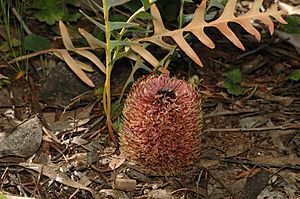Prostrate banksia facts for kids
Quick facts for kids Prostrate banksia |
|
|---|---|
 |
|
| Banksia gardneri in the ANBG | |
| Scientific classification | |
| Genus: |
Banksia
|
| Species: |
gardneri
|
| Synonyms | |
|
|
Banksia gardneri, also known as prostrate banksia, is a special type of shrub. It grows flat along the ground. This plant is found only in Western Australia. Its leaves can be deeply cut or have jagged edges. It usually has rusty brown flowers. After flowering, it forms up to twenty-five oval-shaped seed pods called follicles. You can find this banksia along the western part of Western Australia's south coast.
Contents
Discovering the Prostrate Banksia
Banksia gardneri is a shrub that spreads out flat on the ground. It has stems that usually lie on the soil. This plant has a special woody swelling underground called a lignotuber. This helps it regrow after a fire.
Leaves and Stems
The stems of the prostrate banksia are often hairy. Its leaves can be "pinnatipartite," which means they are deeply divided into many lobes. They can also be "serrated," meaning they have saw-like edges. These leaves are about 100 to 280 millimeters (4 to 11 inches) long. They are also 20 to 60 millimeters (0.8 to 2.4 inches) wide. Each leaf sits on a stalk called a petiole, which is 40 to 120 millimeters (1.6 to 4.7 inches) long. The lobes on the sides of the leaves are shaped like triangles or oblongs.
Flowers and Fruiting Heads
The flowers grow in a dense cluster called a head. Each flower head is 35 to 100 millimeters (1.4 to 3.9 inches) long. When the flowers open, the head is 40 to 60 millimeters (1.6 to 2.4 inches) wide. At the base of the flower head, there are hairy leaf-like structures called involucral bracts. These are 10 to 30 millimeters (0.4 to 1.2 inches) long.
The flowers are usually rusty brown. They have a cream-colored style, which is part of the flower's reproductive system. The outer part of the flower, called the perianth, is 17 to 26 millimeters (0.7 to 1 inch) long. The pistil, which is the female part of the flower, is 18 to 30 millimeters (0.7 to 1.2 inches) long.
Flowering Time and Seeds
Banksia gardneri flowers from April to November. After flowering, each head can form up to twenty-five seed pods. These pods are called follicles. They are oval-shaped and covered in dense hairs. Each follicle is 23 to 40 millimeters (0.9 to 1.6 inches) long. They are also 5 to 20 millimeters (0.2 to 0.8 inches) high and 8 to 15 millimeters (0.3 to 0.6 inches) wide.
Naming the Prostrate Banksia
The prostrate banksia has an interesting naming history. In 1830, a botanist named Robert Brown first described it. He named it Banksia prostrata. However, this name was already in use for a different plant. That plant was from New Zealand and is now known as Pimelea prostrata. Because the name was already taken, Brown's name for the banksia was "illegitimate."
A New Name for the Banksia
In 1981, another botanist, Alex George, officially described the species again. He published its new name, Banksia gardneri, in a science journal called Nuytsia. The "specific epithet" (the second part of the scientific name) gardneri honors Charles Gardner. He was an important botanist who worked for the Western Australian government from 1929 to 1960.
Different Types of Prostrate Banksia
In the same journal, Alex George also described three different types, or "varieties," of Banksia gardneri. These varieties are recognized by the Australian Plant Census. They are:
- Banksia gardneri var. brevidentata has leaves with jagged, saw-like edges.
- Banksia gardneri var. gardneri has leaves that are deeply divided into many lobes. Its flowers are rusty brown and mostly appear in spring.
- Banksia gardneri var. hiemalis also has deeply divided leaves. Its flowers are pale pink and pale brown, and they mostly bloom in winter.
Where the Prostrate Banksia Grows
Banksia gardneri grows in several different types of natural areas. These include shrubland, low woodland, and a unique type of shrubland called kwongan. You can find it mainly in Western Australia. It grows between the towns of Cranbrook, Ravensthorpe, and Harrismith, stretching down to the south coast of the state.
Conservation Status
The Western Australian Government's Department of Parks and Wildlife has classified this banksia as "not threatened." This means it is not currently at risk of disappearing.
Images for kids
- Taylor, Anne; Hopper, Stephen (1988). The Banksia Atlas (Australian Flora and Fauna Series Number 8). Canberra: Australian Government Publishing Service. ISBN 0-644-07124-9.



